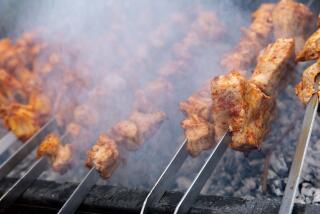Buran’s Baby
- Share via
People like to think that the foods of ancient societies are unchanging, but they couldn’t be more wrong. Cookery changes all the time, everywhere.
Take the dish named for Buran, the wife of a 9th century caliph of Baghdad. Buran’s wedding was famous as the most lavish of the Middle Ages; when the groom arrived, he was led to a carpet of woven gold and a thousand pearls were poured over his head, just because a court poet had once described the bubbly surface of a glass of white wine as “pearls scattered like pebbles on a plain of gold.”
By the 10th century, a cookbook gave recipes for fried eggplant named for Buran. In the 13th century, a more elaborate dish called buraniyya, consisting of stewed meat cooked with fried eggplant, was being made from Iraq to Spain. This dish is still current in Morocco, where it’s called braniya. The Spanish version, alboronia, has lost the meat and become a vegetable stew that includes eggplant.
Meanwhile, back in Iraq and Syria, cooks had started making buraniyyas using other vegetables besides eggplant. The modern Syrian burani is made from meat with any of a number of vegetables--but never with eggplant, probably because so many other eggplant stews have been developed there.
In Iran, Buran’s dish took a different turn. There, the fried eggplant was mixed with yogurt instead of stewed meat. Today there are dozens of boranis in Iran and neighboring countries, made with vegetables from spinach to beets as well as from eggplant. (By the way, none of these dishes should be confused with biryani, which comes from a Persian word meaning “fried.”)
In Turkey and Greece, burani became a dish of vegetables stewed with grain. By the time buranija reached Serbia and Croatia, the rice was replaced by green beans. Buran, for one, would be pretty surprised by it all.
More to Read
Eat your way across L.A.
Get our weekly Tasting Notes newsletter for reviews, news and more.
You may occasionally receive promotional content from the Los Angeles Times.

![LOS ANGELES, CA - JUNE 17: [Cody Ma and Misha Sesar share a few dishes from their Persian Restaurant Azizam] on Monday, June 17, 2024 in Los Angeles, CA. (Ethan Benavidez / For The Times)](https://ca-times.brightspotcdn.com/dims4/default/7ffc7f6/2147483647/strip/true/crop/5110x3417+306+0/resize/320x214!/quality/75/?url=https%3A%2F%2Fcalifornia-times-brightspot.s3.amazonaws.com%2F79%2Fdc%2F4d29255545f5b9813315901692bc%2F1459972-fo-azizam-review20-eba.JPG)








